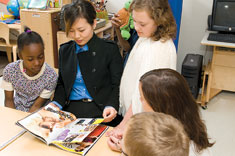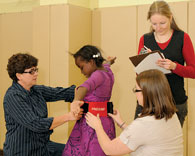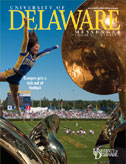Kids' body image, motor skills affect obesity

RESEARCH | Two faculty members who are investigating very different aspects of the complex and growing problem of childhood obesity in America are working with youngsters on the UD campus to conduct their research.
Preschoolers at the University’s Early Learning Center and the first- through eighth-graders who attend The College School are part of a “living laboratory” that researchers Nancy Getchell and Jaehee Jung are using to gather data. Getchell is studying the relationship between motor competency and physical fitness in preschoolers, while Jung is exploring body dissatisfaction and patterns of media use among preadolescents.

“There’s a general assumption that very young children get all the exercise they need by just running around,” says Getchell, who is an associate professor of health, nutrition and exercise sciences. “But this turns out not to be true. What we’ve found is that they do much better with structured physical activity.”
Getchell and Sam Logan, who completed a master’s degree in exercise science in 2008, administered a motor proficiency test to a group of preschoolers and measured their body composition to determine whether there was a relationship between the two factors.
While they found that the relationship was not statistically significant when the data were analyzed for the entire subject pool, it was significant when the children were broken down into groups. “What we discovered was that the group with the highest body fat had the lowest level of motor proficiency,” Getchell says.
“What we’re concerned about is the spiraling effect. Children who don’t develop early motor competency tend to become less active over time, resulting in even lower proficiency and an increased risk of obesity. The relationship becomes stronger as kids get older.”
As her work continues, Getchell is planning a series of studies during a sabbatical in the spring, which she will spend at the University of Otago in New Zealand, where she hopes to learn more about “physical factors and obesity across the lifespan,” she says.
While Getchell’s overall research interests center on the development of motor skills, Jung’s interests focus on the psychological, social and cultural issues associated with obesity. An associate professor of fashion and apparel studies, Jung recently studied a group of 50 boys and girls, ages 8-11, to determine their level of satisfaction with their own bodies as well as their media consumption and image perception patterns.
The results of the study, carried out in collaboration with Michael Peterson, professor of health, nutrition and exercise sciences, were reported in Family and Consumer Sciences Research Journal.
The children’s height and weight were measured to determine their body mass index, and they were interviewed about their media consumption behaviors—that is, frequency, content and preferences for a variety of media including TV, magazines and video games.
“We found marked differences between boys and girls in their ideal body preferences,” Jung says. “The boys chose the larger images as ideals, showing a preference for body types like the figures they see in video games and action toys. On the other hand, the girls wanted to be thinner than their perceived actual body size.”
Jung notes that there is “a huge discrepancy” between what is seen as ideal and the average person. “Kids have a hard time understanding that the images they see in the media represent only a very small percentage of people in America,” she says.
Article by Diane Kukich, AS ’73, ’84M





